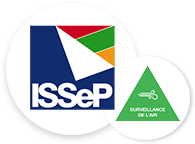Following the COVID-19 pandemic, drastic measures have been taken to limit the spread of the virus. Stopping, slowing down or modifying a series of activities and, in particular, limiting movement has had an impact on air quality.
The Cabinet of the Minister of the Environment asked the ISSeP, in collaboration with AwAC and CELINE, to study the evolution of air quality and to write a report on this unprecedented situation.
This report studies the impact of lockdown measures on the ambient air quality in Wallonia, and more particularly on the pollutants measured by the real-time monitoring network (nitrogen oxides, particles, black carbon, ozone and carbon monoxide), via two complementary approaches:
- The first is based on the analysis of data during the lockdown period and a comparison with previous years.
- The second approach uses modelling to estimate the levels that would have been measured if lockdown had not taken place and to compare them to actual measurements.
The weather played a crucial role during the lockdown period, with conditions most often unfavourable to good air quality.
Compared to previous years, a decrease in nitrogen oxide concentrations (-32% in urban areas for nitrogen dioxide) was observed following the reduction in traffic (-75% in Charleroi). On the other hand, lockdown does not seem to have had an effect on particle concentrations (unfavourable weather conditions, formation of secondary aerosols, limited impact of traffic on particle emissions).
The modelling allowed a comparison to be made between a non-lockdown scenario and reality. This shows a positive impact (reduction) on pollutants directly linked to traffic (nitrogen oxide, black carbon), a limited impact on fine particle concentrations, and a negative impact (increase) on ozone concentrations.
The positive effect wears off quickly as soon as the lockdown is lifted, which confirms that improving air quality requires structural measures to reduce long-term emissions such as changes in mobility (LEZ, public transport, soft mobility, etc.) or societal modes of operation and organisation (teleworking, etc.).
The complete report is available here








